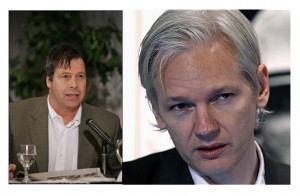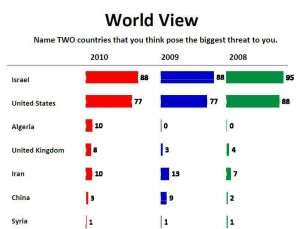Updated below:
The Pentagon Papers are a thing of the distant past, and the New York Times isn’t exactly giving Julian Assange the Ellsberg treatment. In fact, it gave its war-adoring soldier fanboy reporter the assignment of penning a hatchet job on Assange.
Still, the Times was on board (sort of, and selectively) with the latest wikileaks release, tens of thousands of cables showing the U.S. government in a most unflattering light. To my eyes, the most newsworthy were the ones where Hillary signed off on outright spying on diplomats from other countries, including the secretary general of the UN. Credit card numbers! DNA samples! Oh my God! How low can you go? “Mr. Secretary General, I notice a stray gray hair there. One sec, I’ll just … Got it! See, that didn’t hurt, did it? Uh, no, I’ll just put it in this little plastic pouch for safekeeping…..”
Pretty shocking, right?
For the Times, not nearly as important as … drum roll, please … what the cables revealed about What a Major Threat Iran Represents! Especially now that we know Arab princes don’t like the Persians, and are afraid of them, and want America to stop them in their phantom nuclear weapon-making.
Three reporters cobbled together a compendium of Iran Threat-related snippets, and wove a narrative about just how hard it has been to convince the Russians and the Chinese and Italians to isolate and confront Iran–in the Tom Clancy-worthy phrase, to “cut off the head of the snake.”
That last quote was from King Abdullah of Saudi Arabia, who has a very low opinion of Iran, for reasons the Times doesn’t quite spell out.
To its credit, the Times does actually use the phrase “Arab obsession with Iran” and briefly mentions “the uneasy sectarian division of the Muslim world, between the Shiites who rule Iran, and the Sunnis, who dominate most of the region,” but in general takes the worries of the corrupt Gulf oligarchs at face value, as they show how RIGHT the Times has been to pursue its own obsession with Iran (which is, after all, Our Threatiest Threat.)
One would have wished for a little more context here, something like that supplied by the Guardian (bold face mine in all instances below):
Arab-Persian enmity, with a strong undercurrent of rivalry between Sunni and Shia Muslims, dates back centuries but increased markedly after the overthrow of the shah and the Islamic revolution in 1979 and is now viewed as a struggle for hegemony in the region. The conservative Sunni-ruled regimes in Saudi Arabia and the other Gulf states detect the “hidden hand” of Iranian subversion, sometimes where none exists.
Or better, like that offered by Jason Ditz at Antiwar.com:
The calls to attack are nominally presented as about Iran’s civilian nuclear program but seem to center around the king’s belief that Iran is uniquely “evil” and needs to be stopped to save the region. Given that the Saudi King and the Iranian Supreme Leader are extremely influential in two rival sects of Islam, the effort seems more aimed around getting the US involved in a Holy War of sorts than stopping Iran’s modest civilian enrichment program.
That Saudi Arabia is putting forth so much effort to start a major regional war along sectarian lines would be troubling in and of itself, but doubly so as the Obama Administration has just completed agreeing on the largest arms sale in US history to Saudi Arabia.
The $60 billion arms sale was couched as important for regional stability. Yet this is the exact same Saudi government that is pressing for the Obama Administration to start a major, region-wide war which would destroy any such stability. It seems then that the arms sale is more about enabling Saudi Arabia to potentially start this major war themselves.
Yes! You’d think a $60 billion arms sale to an Iranian rival–and the only crazier, more unstable, and religiously unhinged regime in the region–would merit a mention in the Times account, but you would be thinkin’ wrong.
Shockingly, the Times offers the last word to an appalling little piece of racist nonsense offered by Crown Prince bin Zayed of Abu Dhabi, who is quoted in one cable as saying:
“Any culture that is patient and focused enough to spend years working on a single carpet is capable of waiting years and even decades to achieve even greater goals.” His greatest worry, he said, “is not how much we know about Iran, but how much we don’t.”
Forget about the carpet weirdness, that last line is PERFECT. Team B thinking at its best.
If you don’t know about Team B, you should spend some time googling around on the subject. Basically, it boils down to this:
Not finding evidence of Something is just more proof that that Something is there, and further, the not finding it just means that the people hiding that Something are incredibly sneaky.
This little exercise in tautology is a recipe for a long and lucrative career in the government of the United States. You are never right, but never wrong!
The track record of Team B is not so good, but these clowns stay in government no matter what. With Russia: embarrassingly wrong. With Iraq. Ditto. And now with Iran.
No matter what intelligence and inspections show, the U.S. government KNOWS those sneaky, rug-making sons of bitches are up to something. And now we have the word of a Crown Prince.
Update: FAIR goes into more detail on just how much spin the Times is putting on the cables, by comparing the Times’ selective excerpting with the cables themselves (which are not available from the Times, but can be viewed at the wikileaks site itself, or the Guardian’s.)
FAIR also has a succinct description of the Times’ behavior in all of this:
WikiLeaks document dumps are largely what media want to make of them. There’s one conventional response, which goes something like this: “There’s nothing new here, but WikiLeaks is dangerous!” But there’s another option: “There’s nothing here, except for the part that confirms a storyline we’ve been pushing.”






